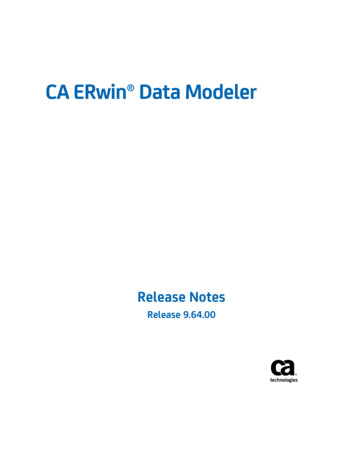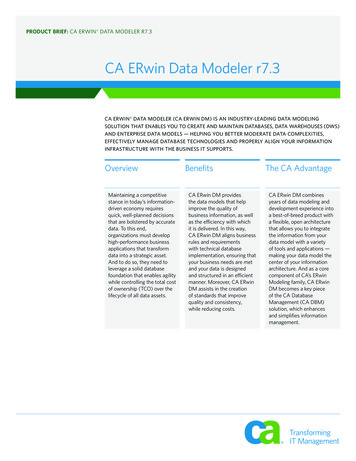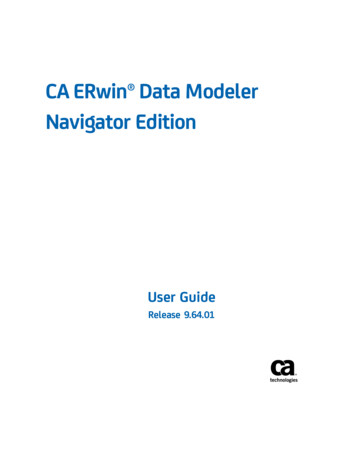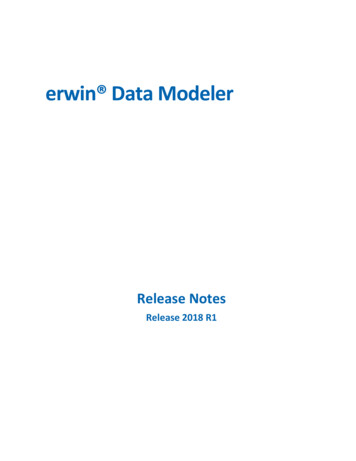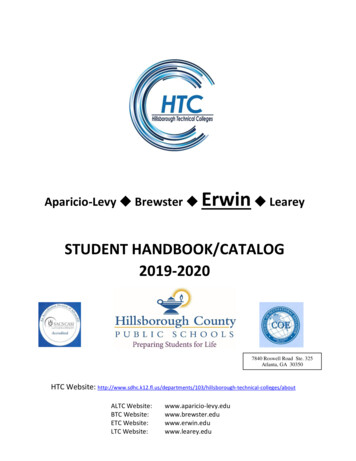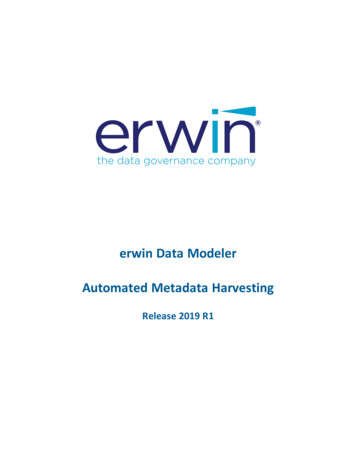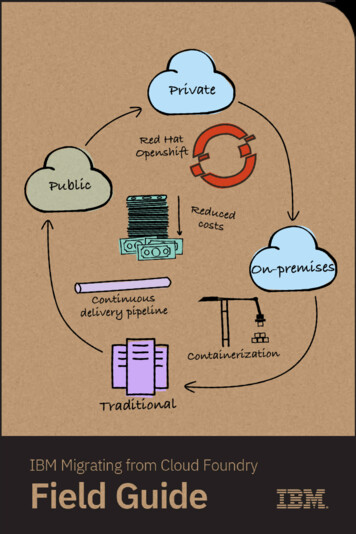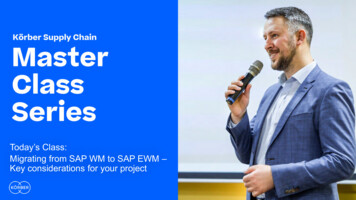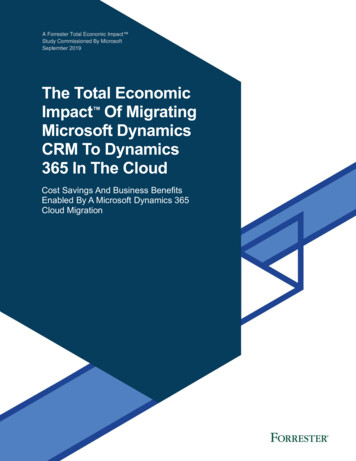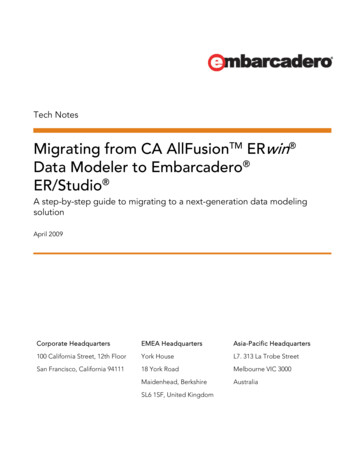
Transcription
Tech NotesMigrating from CA AllFusionTM ERwin Data Modeler to Embarcadero ER/Studio A step-by-step guide to migrating to a next-generation data modelingsolutionApril 2009Corporate HeadquartersEMEA HeadquartersAsia-Pacific Headquarters100 California Street, 12th FloorYork HouseL7. 313 La Trobe StreetSan Francisco, California 9411118 York RoadMelbourne VIC 3000Maidenhead, BerkshireAustraliaSL6 1SF, United Kingdom
Migrating from CA AllFusionTM ERwin Data Modeler to Embarcadero ER/StudioINTRODUCTIONThe volume of data is growing dramatically and the structures of the databases that house thatdata are more complex than ever before. Companies are now looking to their data models tohelp them understand their data assets in new and intricate ways. Data models that might haveonce focused solely on understanding the structure of the database for application developers,are now being called on to solve fundamental business questions like, “what is the singledefinition of a customer?”. As companies look toward solving these business problems theyneed to take advantage of the high end features available in data modeling tools. When ERwinusers look at things like metadata impact analysis and traceability, they realize it’s time to makea change.This paper discusses the how and why of making that change, and how upgrading to ER/Studiocan be done in a way that preserves the intellectual capital of legacy data models, whileminimizing the impact of the change. With the numerous next-generation features and benefitsas compared to ERwin, hundreds of Embarcadero customers have found ER/Studio to be anextremely productive and cost-effective alternative.BENEFITS OF ER/STUDIO OVER ALLFUSIONERWIN DATA MODELERSUPERIOR MODEL FILE SYSTEM TECHNOLOGYER/Studio allows users to create multiple, mutually independent physical models from onecommon logical model within the same .dm1 file; ERwin requires multiple files to achieve thesame effect thus losing the traceability between the logical and physical artifacts. ER/Studio’sseparate but integrated approach offers the user a complete, easy to understand solution forsynchronizing and updating logical models, physical models and live databases without havingto manage and synchronize many loose files. These features enable administrators to: Support database applications existing on heterogeneous database platforms such Oracleand Microsoft while maintaining traceability to the original logical model.Prototype applications on non-production systems such as Access and subsequently movethem to a more robust RDBMS, such as Oracle, Sybase or Microsoft, without having tomanage multiple files.Maintain physical data models for test, development and production environments within asingle environment.Impact analysis and traceability provided via “Where Used” capabilities.SUPERIOR METADATA IMPACT ANALYSIS AND TRACEABILITYER/Studio provides features for maintaining the traceability between the original logical modeland multiple physical models. Coupled with ER/Studio’s ability to maintain multiple modelswithin the same file, impact analysis is far easier and more reliable than with ERwin. In additionto reports, ER/Studio also provides a “Where Used” feature which includes the followingcapabilities:Embarcadero Technologies-1-
Migrating from CA AllFusionTM ERwin Data Modeler to Embarcadero ER/Studio “Where Used” identify where logical business entities are used in multiple physical modelsto assess usage, impact analysis and general data enterprise.“Where used” also identifies logical entities that have been ‘denormalized’ in physicaldatabase designs.“User-defined” mappings allow the modeler to map two disparate logical and physicalmodels when a bottom-up approach is needed.An example of “Where Used” showing two physical tables with different names derived from asingle logical entity is shown in Figure 1:Figure 1 Entity EditorSUPERIOR VISUAL DATA LINEAGE FEATURESDocumenting data lineage between systems is more critical than ever as data models areleveraged for SOA implementations, data warehouse projects, CDI/MDM projects and otherdata integration purposes. ER/Studio offers modelers visual data lineage functionality tovisually represent how data is mapped between systems. This allows modelers to drivesource/target mappings from the model rather than managing them separately in, say, an Excelspreadsheet or Access database. The data flow components are also integrated withER/Studio’s Where Used technology to provide impact analysis of what entities/tables areinvolved in what data flow processes.Embarcadero Technologies-2-
Migrating from CA AllFusionTM ERwin Data Modeler to Embarcadero ER/StudioSUPERIOR DIAGRAM LAYOUT FEATURESA common challenge to data modelers is producing a readable diagram. ER/Studio providesthe industry’s most effect options for automatic layout of diagrams. These options areparticularly useful when reverse engineering from source that do not contain diagraminformation, such as .sql DDL files and database catalogues.Users can choose from the following general layout types: connect ElementsEach of these layout types contains extensive options to ensure that the resulting diagram isreadable and understandable.SUPERIOR DIAGRAM NAVIGATIONER/Studio is designed to dramatically increase user productivity through superior navigation oflarge, complex data models. This saves time when searching for deeply buried elements in amodel. ER/Studio provides a number of features to assist with the management of largemodels, such as: Multiple levels of nested Submodels (i.e. Submodels of Submodels of Submodels ),allowing modelers to present simpler “subset” diagrams that focus on specific areas ofinterest.Numerous navigational aids, including:- Interactive panning and zoom features in the main diagram window.- Relationship navigation enabling the user to move to the entity at the far end of arelationship; this feature automatically pans through the diagram if necessary.- An Overview Window enabling the user to pan through the diagram via a thumbnailview.- A Zoom Window to display items under the mouse cursor in a separate window at100% magnification. This is useful for examining detail of a complex diagram whenthe main diagram window is at a very low level of magnification, e.g. “zoomed out”.- A variety of significantly superior diagram object display options such as: Displaying logical names alongside physical names if preferred Displaying indexes bound to tables Displaying “Attachments” (i.e. UDPs) on entities/tables Displaying ‘code’ objects (procedures, materialized views, functions, etc) onthe diagram displayEmbarcadero Technologies-3-
Migrating from CA AllFusionTM ERwin Data Modeler to Embarcadero ER/StudioSUPERIOR MODEL PUBLISHING AND COMMUNICATIONER/Studio Enterprise includes a web portal that allows for “near” real-time publication of theinformation contained in the ER/Studio repository (offered with the Enterprise Edition). Theportal allows developers, DBAs and business analysts to browse, search and report on themodel metadata via a web browser. It drastically streamlines the process of communicating themodels by offering a “self-service” method for publishing the information. The data architectsno longer need to refresh reports any time a model changes. The portal has a separatereporting repository that is optimized for searching and reporting that is kept in synch with theER/Studio repository via an ETL process.SUPERIOR META MODEL AND PRODUCT EXTENSIBILITYMETA MODEL EXTENSIBILITYER/Studio’s widely leveraged ‘Attachments’ system feature is designed to allow users to ‘attach’new and unique metadata to any portion of a data model for user-specific needs. This helps toensure the data model can be leveraged by an organization for a wider audience, allowing thedata models to offer more than just ‘classic’ entity, attribute, datatype, and relationshipinformation.Attachments allow organizations to include metadata that document anything from datagovernance policies, to data stewardship, to workflow information. ER/Studio also allows anarchitect to incorporate security classification schemes, map privacy policies to the data ordocument relevant compliance laws.PRODUCT EXTENSIBILITY THROUGH THE AUTOMATION INTERFACE USING VBAER/Studio allows users to utilize built-in VB macros to gain programmatic access to the entireapplication ‘shell’. Users can modify one of dozens of existing macros or build their own macrosto extend the existing functionality to meet their specific business needs. Examples of simplemacros include exporting the model to an Excel spreadsheet, import reference values fromExcel, data type converters, primary and foreign key constraint generator, and many others.SUPERIOR METADATA CAPABILITIESBoth ER/Studio and ERwin offer dictionary systems which allow creation and access to reusablecomponents such as domains, rules, valid values, etc. However, the similarities end there.ER/Studio’s Data Dictionary system and Where Used interfaces ensure infinite levels of objecttraceability.THE DATA DICTIONARY IN ER/STUDIO PROVIDES MODELERS WITH THE FOLLOWING: It is reusable and importable across disparate ER/Studio model files (without the need for acollaborative Repository).It is recursive in that reusable objects can be used within other reusable objects (e.g. aDefault can be created once, and then reused in many Domains).It includes a much wider set of reusable objects (e.g. Attachments, Domains, ReferenceValues, Naming Standards Templates, Attachments, Defaults, Rules, Template Proceduresand Triggers and more) than ERwin.Embarcadero Technologies-4-
Migrating from CA AllFusionTM ERwin Data Modeler to Embarcadero ER/Studio It offers superior metadata traceability through Binding Information Interfaces found in theData Dictionary and other key objects to quickly display where elements (e.g. Domains) havebeen bound in the diagram in order to assess the impact of change.With the Enterprise version of ER/Studio, the data dictionaries can be shared dynamically acrossany model in the repository allowing an architect to enforce standards enterprise wide.Changes to an enterprise dictionary object will propagate to any model leveraging that object.PLAN THE CONVERSIONPlanning lays the groundwork for the conversion project which helps avoid many potentialpitfalls and landmines. It also helps determine the time and effort needed for the process.PERFORM AN INVENTORY AND ASSESSMENT OF CURRENTMODELSThe first step in converting to another modeling product is to understand the investment in thecurrent modeling product. This involves identifying and analyzing all the models that have beenproduced in ERwin.If ERwin’s model manager is being used, the inventory is easy. The models should all reside inthe model manager; however, you should verify that all of the models are in fact being kept inERwin’s model manager.If they are not in the model manager, the process may be much more difficult. It is necessary toidentify all models in use throughout the organization. In the best case, there will be only a fewenterprise models that have grown over the years that need to be converted. More likely, therewill be many models distributed across the organization in various departments. They may liveon a developer’s or DBA’s personal computers, various network drives or even in someone’semail inbox. The important thing is to create an inventory of the models that exist, where theyare located, and who owns and maintains them.After completing the initial inventory, the next step is to determine which models are in use andthe nature of their usage. This will determine the time and resources needed in the conversioneffort. Many companies have hundreds of models throughout their organization. Some ofthese may be under active development and change. Some of them may be effectivelycomplete and subject to no or little change. Some of them may be antiquated and no longer inuse. Identifying the usage of models will determine which models require conversion and willhelp estimate the resources and time needed for conversion.Another point to consider is the nature of the models. Some models may be applicationspecific and very physically oriented. They arose to manage a specific database, generate DDLand make changes to the structure. These typically have little or no “logical” information, andmay not even have a logical model. In this case, it may be less costly to use ER/Studio toreverse engineer the live database rather than convert the ERwin model. Reverse engineeringensures that models exactly match the database structure they are meant to support. Thisremoves the need to validate the model structure for accuracy after the conversion and avoidspotentially losing information such as storage parameters, triggers, stored procedures andother physical objects, which may not migrate during the translation. Further, these types ofmodels are often not kept in synch with the database implementation.Embarcadero Technologies-5-
Migrating from CA AllFusionTM ERwin Data Modeler to Embarcadero ER/StudioUnfortunately, reverse engineering from the live database will only work for a small subset ofmodels. Mature data models contain much more information than is contained in theimplemented database. Logical information such as subject areas, business rules, businessnames and definitions cannot be reverse engineered from the database catalog. Thisinformation is too vital to lose. The target audiences of the models have grown outside thetechnical arena. Many business analysts rely on the logical data models as roadmaps to guidethem in producing reports instrumental to marketing campaigns, customer profiling andinventory analysis. Note that with these types of models, the physical models should becompared and synched with the target databases to ensure that the physical models are currentand correct prior to conversion to ER/Studio.DEFINE A CONVERSION PROCESSA process for converting ERwin files and models to ER/Studio should be defined. Key decisionsthat will need to be made as part of this process include: Which models are to be converted to ER/Studio?When should the models be converted?Should ERwin physical models be validated and synched prior to conversion? Or should thisprocess be applied to the resulting ER/Studio models?Who will perform the conversion?Who will be responsible for verifying the resulting conversion?Who will be responsible for future maintenance of the ER/Studio models?KEY FACTORS TO CONSIDER INCLUDE: Are the models stable and effectively complete? Or are they still under active modification?What type of databases, if any, are the models used to maintain? Are the database(s)maintained via tools other than the modeling tools?CONVERSION PROCESSThe conversion process is designed to help maintain investments in legacy models and modelmetadata managed in ERwin 3.5.2, 4.1.x or ERwin r7.x, and to ensure a seamless transition toER/Studio.The process of converting from ERwin to ER/Studio depends on the version of ERwin in use.Converting from pre-4.x and pre-r7x versions of ERwin is a simple task. ER/Studio has a nativeERX import which can be leveraged to directly import the model into ER/Studio, whichmaximizes the amount of information imported into ER/Studio.In version 4.0 and later, the ERX export is no longer available. Fortunately, an add-on toER/Studio is available to import and export metadata from a variety of sources. This not onlyallows you to import models from ERwin 4.1.x or r7.x, but allows you to integrate your modelmetadata to a wide spectrum of other BI, ETL and metadata interchange formats.For a complete list please refer to the Embarcadero Technologies io/MIRModelBridges.xml).Embarcadero Technologies-6-
Migrating from CA AllFusionTM ERwin Data Modeler to Embarcadero ER/StudioCONVERTING FROM COMPUTER ASSOCIATES ERWIN 3.5.2Note: Before beginning the import process, you need to use Erwin 3.5.2 and save the model asan ERX file by going to File Save As and selecting ERX from the file type drop down.ER/Studio lets you import ERX files from ERwin 3.5.2 directly. To import an ERX file, perform thefollowing:1. Launch ER/Studio.2. Go to File New.3. Select the third option Import Model From:4. Select ERX file from the dropdown list5. Click the Import button6. Browse to the ERX file you want to import.7. Click Open. ER/Studio imports the ERX file and creates a dm1 file with a logical andphysical model.8. The file name defaults to the name of the ERX file. Go to File Save to save the model toyour local drive or a network drive.9. You may also opt to insert the models into ER/Studio Repository if it is installed. In this casego to Repository Diagrams Add. ER/Studio launches a dialog to initialize somediagram information, such as author, diagram name, project etc.Embarcadero Technologies-7-
Migrating from CA AllFusionTM ERwin Data Modeler to Embarcadero ER/StudioCONVERTING FROM ALLFUSION ERWIN DATA MODELER 4.1.XAND R7.XER/Studio can import metadata from ERwin 4.1.x .er1 or ERwin r7 .erwin files by leveraging itsadd-on module MetaWizard. You must first save your .er1 or .erwin file in their XML format. Ifyou have ERwin installed on the same machine as ER/Studio, the bridge will do this for you byleveraging the ERwin API.Note: If you do not have ERwin on the same machine as ER/Studio, you need to save the .er1file as an .xml file prior to importing into ER/Studio.ERwin 4.1.x .er1 and r7 .erwin files are notorious for having corrupt data. Before saving the fileas an .xml file, you should run their diagnostic check on the .er1 file.Use Erwin to clean up the file, go to Tools Diagnostics . This cleans up the .er1/.erwin filebefore the import into ER/Studio. Once the repair is complete, you can go to File Save As and select .xml as the file type. If you intend to have the bridge convert the .er1 or .erwin file to.xml then just proceed to the conversion steps.Note: You many need to contact Embarcadero Technologies for a trial license of MetaWizard.Import and Export Bridges are separately licensed. Contact sales@embarcadero.com.To import an ERwin .xml/.er1/.erwin file, perform the following:1. Launch ER/Studio.2. Go to File New.3. Select the last radio option, Import Model From:.4. Select External Metadata from the list. This launches MetaWizard.Embarcadero Technologies-8-
Migrating from CA AllFusionTM ERwin Data Modeler to Embarcadero ER/Studio5. Select CA AllFusion ERwin 4.x Data Modeler or CA AllFusion 7.x Data Modeler from the list.6. Browse to the ERwin .xml file that you previously saved or the .er1/.erwin file if you intend tohave the bridge do the conversion.7. Click Next. MetaWizard validates the XML file for any errors or inconsistencies.8. Click Finish. ER/Studio imports the Logical and Physical model.9. The file name defaults to the name of the ERwin file name with an extension of .dm1(ER/Studio native file extension). Go to File Save to save the model to your local drive ora network drive.10. You may also opt to insert the models into ER/Studio Repository if it is installed. In this caselog into the repository and go to Repository Diagrams Add Diagram. ER/Studio willlaunch a dialog to initialize some diagram information, such as author, diagram name,project, etc., shown in Figure 2.Embarcadero Technologies-9-
Migrating from CA AllFusionTM ERwin Data Modeler to Embarcadero ER/StudioFigure 2 Add Diagram in ER/Studio RepositoryVALIDATION OF CONVERSION PROCESSIn addition to converting the basic model objects such as entities, attributes, table, columns,etc, ER/Studio translates the ERwin file to ensure that other critical data is preserved, such as: ERwin Diagram Aesthetics (Layout, Color, Font, etc)ERwin Subject Area ImportationERwin UDP Importa
Migrating from CA AllFusionTM ERwin . portal allows developers, DBAs and business analysts to browse, search and report on the model metadata via a web browser. It drastically streamlines the process of communicating the models by offering a “self-service” m
